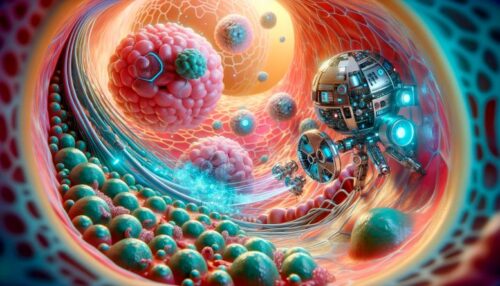- The study, carried out using mice as test subjects, illustrates the propulsion of minuscule nanomachines driven by urea found in urine.
- These nanomachines exhibit precise targeting capabilities as they engage tumours with a radioisotope attached to their surface.

Bladder cancer stands as one of the most prevalent cancers globally, ranking as the fourth most common tumour in men. Despite its relatively low fatality rate, nearly half of bladder cancer cases experience a recurrence within five years, necessitating continuous patient monitoring. The frequent hospital visits and repeated treatments associated with this disease contribute to its status as one of the costliest cancers to treat.Current treatment methods, which involve the direct administration of drugs into the bladder, exhibit respectable survival rates but are plagued by limited therapeutic effectiveness. A promising alternative lies in the deployment of nanoparticles designed to deliver therapeutic agents directly to the tumor site. Among these innovative nanomachines are nanorobots, tiny particles equipped with self-propulsion capabilities within the body.
The study, led by the Institute for Bioengineering of Catalonia (IBEC) and CIC biomaGUNE in collaboration with the Institute for Research in Biomedicine (IRB Barcelona) and the Autonomous University of Barcelona (UAB), holds great promise for revolutionizing bladder cancer treatments. These advancements aim to reduce hospitalization duration, subsequently lowering costs and improving patient comfort. This study showcases how researchers successfully reduced bladder tumors in mice by an impressive 90% with just one dose of urea-powered nanorobots. These minuscule nanomachines consist of porous silica spheres, bearing specific components with distinct functions. Notable elements include urease enzymes, which react with urea in urine, propelling the nanoparticles, and radioactive iodine, a radioisotope commonly employed in localized tumor treatment.
The next phase of research, already in progress, will focus on monitoring tumor recurrence after treatment. Previous research established that nanorobots’ self-propulsion capabilities enable them to reach all bladder walls, a significant advantage over current procedures where patients must change positions to ensure drug distribution. The recent study goes further by demonstrating not only the mobility of nanoparticles within the bladder but also their specific accumulation in tumors. This achievement was made possible through advanced techniques, including medical positron emission tomography (PET) imaging and fluorescence microscopy, which allowed researchers to track the nanorobots’ movements within the bladder.
Nanorobots’ pH-Driven Breakthrough for Targeted Therapy
The ability of nanorobots to penetrate tumors presented a challenge, as these particles lack specific antibodies to recognize tumor tissue. However, the study revealed that nanorobots increase local pH levels through a self-propelling chemical reaction, breaking down the tumor’s extracellular matrix and facilitating penetration and accumulation within the tumor. The researchers concluded that nanorobots collide with the urothelium like a wall but penetrate the spongier tumor, thanks to their mobility. Additionally, localized administration of nanorobots carrying radioisotopes reduces the risk of adverse effects while enhancing the therapeutic impact.
Innovative microscopy techniques were employed to visualize nanorobots within tissues and tumors, addressing a significant scientific challenge. A new method based on polarized light was developed to cancel out scattering from tumor tissue and cells, enabling the precise location and visualization of nanorobots without the need for prior tagging with molecular techniques.”With a single dose, we observed a 90% decrease in tumor volume, which is significantly more efficient compared to the 6 to 14 hospital appointments typically required for current treatments,” explains Samuel Sánchez, the study’s leader and ICREA research professor at IBEC.Reference: “Radionuclide therapy with accumulated urease-powered nanobots reduces bladder tumor size in an orthotopic murine model” 15 January 2023, Nature Nanotechnology.
DOI: 10.1038/s41565-023-01577-y





